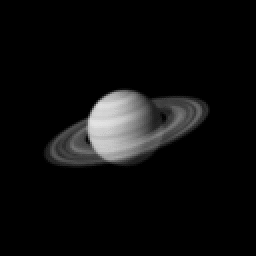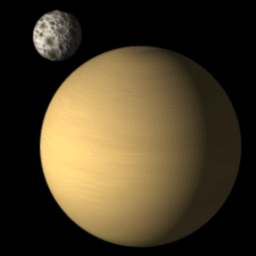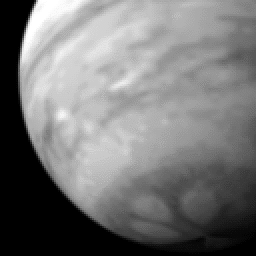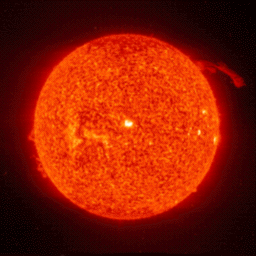The CATS mission to the Eliot main asteroid belt snapped a picture of Equitone using its Low Resolution Imager (LRI). The image was taken from a distance of 960000 km, and the apparent angular diameter of Equitone on the image was measured to be 3 deg 30' 35''. What is the diameter of Equitone in kilometers?

Given this image, and the above information, estimate the inner and outer radii of the Equitone ring system, and compare this to the Roche limit for Equitone.
The RECON orbiter was injected into orbit around Equitone with an orbital semimajor axis of 290000 km. The period of this orbit was 5 days 10 hrs 16 min. What is the mass of Equitone in kilograms?
How does the mass and diameter of Equitone compare to the mass and equatorial diameter of the Earth? What is the mean density of Equitone and what is the likely composition?
The multitude of missions to Phlebas found a planet with two small moons. The outermost moon has an elliptical orbit with a radius that ranges from 39000 km to 65000 km. What is the semimajor axis and eccentricity of this orbit? If the orbital period is 1.17 days, what is the mass of Phlebas? How does this compare to that of the Earth?

The diameter of Phlebas was measured to be 1.21 times the diameter of the Earth. What is the average density of Phlebas and what is its probable composition? Discuss the likely effects of differentiation.
Compute the surface gravity (in terms of g on the Earth), and the escape velocity of Phlebas.
The surface albedo of Phlebas is 0.3. Only a minimal atmosphere was found. What is the expected temperature of Phlebas and what common gases should be retained?
The High Resolution Imager (HRI) on the SOPCOP orbiter has a camera with 150mm diameter lens and an f-ratio of f/10. What is the focal length of the camera?
The HRI has a CCD detector with 256 x 256 pixels in a square array. If the camera is to have a field-of-view of 0.25 deg x 0.25 deg, what is the pixel size in arcseconds? Given the focal length of the camera, what should the pixel size be in millimeters to give this field of view?
The HRI camera works in the optical with a band center of 5500 Angstroms. What is the resolution (diffraction limit) of the objective lens in arcseconds? Is the HRI camera diffraction limited, or limited by the size of its pixels?
SOPCOP was injected into an orbit with closest approach to Phlebas of around 3 planetary radii. What is the resolution of the HRI on the surface below in meters per pixel?

The moon is found to have an orbit with a semimajor axis of 108000 km, and a period of 6.89 days. Estimate the reduced mass of the Tiresias system. From the image, use the apparent angular diameter of the moon relative to Tiresias to find the moon's diameter in kilometers (be sure to correct for the different distance - in this image, the moon is beyond Tiresias). What are the approximate average densities of Tiresias and its moon? What would this imply for the compositions?
What would you expect the rotational period of Tiresias's moon to be?
The albedo of Tiresias is 0.3 and a significant greenhouse effect has also been measured, with an infrared reflectivity of r=0.65. What is the surface temperature of Tiresias? What would you expect the temperature at the upper cloud deck of Tiresias to be?
What is the pressure scale height of carbon dioxide in the atmosphere of Tiresias?
There is a water molecular emission line at a frequency of 22.235 x 10^9 Hertz (22.235 GHz). What is the wavelength of this line, and what is the energy difference corresponding to this transition? What sort of instrument would you need to detect this emission?
The planet Hieronymo is truly a giant, with a diameter of 12.4 times the diameter of the Earth! Below is an image taken by the LRI onboard the HAMPA mission.

The six missions sent to Hieronmyo discovered a total of 12 moons. The largest moon has a diameter of 2235 km and is in a close orbit with a semimajor axis of 252000 km and a period of 16.32 hours. What is the mass of Hieronymo?
At the orbit of this moon, what is the tidal gravitational force dF/dR (in N/m) exerted by Hieronymo? What is the difference in force between the center of the moon and its surface due to tides (in Newtons)? What would you expect the surface of this moon to be like?
How do you expect the compositions of the moons of Hieronymo to vary with different orbital radii?
What do you expect the central pressure and temperature of Hieronymo to be? Assume hydrostatic equilibrium and the perfect gas law, and make the usual approximations.
A large solar flare is noted on the surface of Eliot itself. What is the typical velocity of material ejected during a solar flare (in km/s)? The DOP and Nebraska missions to Eugenides are not equipped with radiation shielding. How long before the solar flare reaches Eugenides, and destroys these spacecraft?




